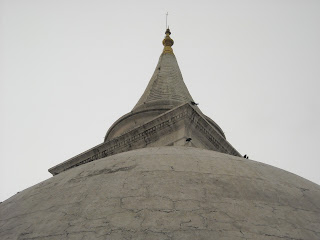During my younger days I was staying in a kampung area where people of different races live in old Malay-styled wooden houses. The place my family stays in is house number 2267. It is an attap-roof stilts wooden house. Actually there are two "semi-detached" houses which shared the same house number. Initially we were staying at the house on the right. This is where my late father passed away in 1970. After our next door Indian family neighbour shifted out, we moved next door to the vacated house. An elderly kuih-making old lady with three grown up sons moves into the house that we vacated earlier.
There is a bathroom in front of the house on the right which both families co-shared. Modern toilet facilities are unheard of during that time and all houses uses the traditional method where all excrements are collected in a "tong najis" (bucket). The midnight soil will be collected by the municipal workers in the early morning between 2am -4am. Sometimes if the workers are not careful and spilled the midnight soil onto the roads surface, it really smells like shit in the morning when we walks past to take our school bus.
As far as I know the so-called "kampung" do not have a proper name but there is one kampung road by the name of Jalan Karim. This small road is accessible from Jalan Maharaja Lela (formerly known as Jalan Batak Rabit) which is one of the main trunk road linking Teluk Intan (formerly Telok Anson). My "kampung" is about four kilometres to the Teluk Intan town centre.
The kampung Jalan Karim run parallel to the stream Sungai Pak Kalong which is a tributary of Sungai Perak. In the absence of computers, Internet and Play Stations, Sungai Pak Kalong was one of our main play ground or swimming pool. During high tide when Sungai Pak Kalong reaches a depth of seven feet, the boys will be having a great time swimming or just playing at the banks of the river.
For those keen on fishing, Sungai Pak Kalong is a boon as the river is a major place to catch fresh water fishes like haruan, ikan keli, sepat and puyu. Since Sungai Perak flows side by side with Jalan Maharaja Lela, fishing accessories like hooks and fishing lines are easily obtainable from one of the sundry shops along the road. We will use whatever discarded wooden staff we can find from a nearby sawmill or cut a small tree branch or long twig to tie the fishing line. As bait for the fishes, we just digged the ground around our houses for earthworms. Within less than half an hour of digging, a bagful of fishbait worms will be available.
When the river reaches ankle length during low tide, some will take the opportunity to scoop the fishes with whatever basket that they can get hold from their house. If one's lucky there will be the surprise catch of the day in the basket, an udang galah. The freshwater prawn move along with the in flow of the tide from Sungai Perak and hides amongst the plants below the river banks during low tide.
Kampung Jalan Karim will be flooded at least twice a year. It is not like those life threatening flood which happens in Johor or Pahang in recent years but just about one to two feet deep. This is as long as we do not swim in the river during specially high tide. The river can be fun but can be dangerous too. I was nearly drown in that river once. I slipped from the side of the river towards the middle of the river bed. Luckily one of my brothers friend caught hold of me and pulled me up.
At the right end of the Jalan Karim kampung is the railway tracks which links Teluk Intan to Tapah town. The railway station is about two kilometres away from the kampung. A railway bridge runs across the Sungai Pak Kalong. During the occasion when a train crosses the bridge while we are swimming, we will stay under the bridge until the train crosses. Imagine the sound from the wheel thumping on the tracks and the metal bridge shaking and vibrating for at least one to two minutes. Those were the days.
The railway track is no more there but replaced with a tarred lane. No one will ever wants to swim in the Sungai Pak Kalong nowadays. The river is so polluted with effluents from nearby factories and motor workshops for so many years that the river water turned from muddy brown to oily black. It is no more looks like a river but a dirty longkang (drain). What a sad case for my water playground.- Loka




































